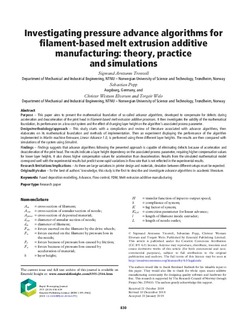| dc.contributor.author | Tronvoll, Sigmund Arntsønn | |
| dc.contributor.author | Popp, Sebastian | |
| dc.contributor.author | Elverum, Christer Westum | |
| dc.contributor.author | Welo, Torgeir | |
| dc.date.accessioned | 2019-11-21T11:30:35Z | |
| dc.date.available | 2019-11-21T11:30:35Z | |
| dc.date.created | 2019-09-20T12:16:15Z | |
| dc.date.issued | 2019 | |
| dc.identifier.citation | Rapid prototyping journal. 2019, 830-839. | nb_NO |
| dc.identifier.issn | 1355-2546 | |
| dc.identifier.uri | http://hdl.handle.net/11250/2629741 | |
| dc.description.abstract | Purpose – This paper aims to present the mathematical foundation of so-called advance algorithms, developed to compensate for defects during acceleration and deacceleration of the print head in filament-based melt extrusion additive processes. It then investigates the validity of the mathematical foundation, its performance on a low-cost system and the effect of changing layer height on the algorithm’s associated process parameter. Design/methodology/approach – This study starts with a compilation and review of literature associated with advance algorithms, then elaborates on its mathematical foundation and methods of implementation. Then an experiment displaying the performance of the algorithm implemented in Marlin machine firmware, Linear Advance 1.0, is performed using three different layer heights. The results are then compared with simulations of the system using Simulink. Findings – Findings suggests that advance algorithms following the presented approach is capable of eliminating defects because of acceleration and deacceleration of the print head. The results indicate a layer height dependency on the associated process parameter, requiring higher compensation values for lower layer heights. It also shows higher compensation values for acceleration than deacceleration. Results from the simulated mathematical model correspond well with the experimental results but predict some rapid variations in flow rate that is not reflected in the experimental results. Research limitations/implications – As there are large variations in printer design and materials, deviation between different setups must be expected. Originality/value – To the best of authors’ knowledge, this study is the first to describe and investigate advance algorithms in academic literature. | nb_NO |
| dc.language.iso | eng | nb_NO |
| dc.publisher | Emerald | nb_NO |
| dc.rights | Navngivelse 4.0 Internasjonal | * |
| dc.rights.uri | http://creativecommons.org/licenses/by/4.0/deed.no | * |
| dc.title | Investigating pressure advance algorithms for filament-based melt extrusion additive manufacturing: theory, practice and simulations | nb_NO |
| dc.type | Journal article | nb_NO |
| dc.type | Peer reviewed | nb_NO |
| dc.description.version | publishedVersion | nb_NO |
| dc.source.pagenumber | 830-839 | nb_NO |
| dc.source.journal | Rapid prototyping journal | nb_NO |
| dc.identifier.doi | 10.1108/RPJ-10-2018-0275 | |
| dc.identifier.cristin | 1727169 | |
| dc.description.localcode | © Sigmund Arntsønn Tronvoll, Sebastian Popp, Christer Westum Elverum and Torgeir Welo. Published by Emerald Publishing Limited. This article is published under the Creative Commons Attribution (CC BY 4.0) licence. | nb_NO |
| cristin.unitcode | 194,64,92,0 | |
| cristin.unitname | Institutt for maskinteknikk og produksjon | |
| cristin.ispublished | true | |
| cristin.fulltext | original | |
| cristin.qualitycode | 1 | |

